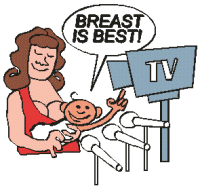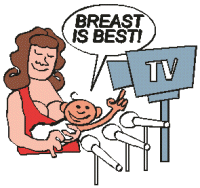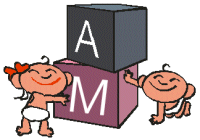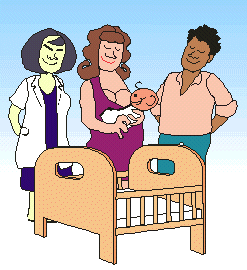
|

Action Folder 1999
Breastfeeding - Education for Life

All over the world there is increasing knowledge and concern about early child development and "significant interactions" in the family. There is widespread interest in improving the quality of child care and in integrating knowledge about the needs of the developing child into our educational systems and content. However, the significance of breastfeeding for human development and the quality of life of families is rarely considered.
The exciting "news" from ongoing research is that BREASTFEEDING IS not only important for health, nutrition and the development of a baby's trust and sense of security, but enhances brain development and learning readiness as well (See Box on P. 3 and page 6 for list of references).
- Special fatty acids in breast milk lead to increased intelligence quotients (IQs) and better visual acuity (Andraca I and Uauy R, 1995, See reference on P. 6).
- Breastfed babies have fewer ear infections, which have been associated with hearing loss and learning delays.
- Several studies have shown better school achievement in breastfed children, even at the end of secondary school and when controlling for social class, mother's education and race.
Therefore, this year's World Breastfeeding Week (WBW) theme addresses the need to integrate information on the importance of breastfeeding into our educational systems at all levels.
The goals of World Breastfeeding Week 1999 on the theme of "Breastfeeding: Education for Life" are to:
- Increase public awareness of the importance of protecting, promoting and supporting breastfeeding as the standard for infant development and growth;
- Encourage the incorporation of education on breastfeeding and appropriate infant feeding practices into all levels of formal and informal education;
- Improve relevant curriculum design with all types of educators and trainers from professional institutions, medical and other teaching schools, health organizations, public and private schools and hospitals and community education centers;
- Involve school children, from preschool onward, and teenagers in WBW 1999 activities and provide tools for popular education appropriate for different age groups;
- Encourage the integration of breastfeeding experiences and practices into children's developmental materials and toys.
Breastfeeding gives a headstart in education
- Breastfeeding enhances optimal brain development provided by nutrients and interaction.
- Breastfeeding protects babies from illness that can cause malnutrition, learning and hearing difficulties.
- Breastfeeding ensures frequent interaction and exposes baby to language, positive social behavior and significant stimuli.
- Breastfeeding enables better visual development and eye focus leading to reading and learning readiness.

|
Why is it important to provide breastfeeding education?
Cultural, emotional and social forces shape our attitudes early in our lives. Families, friends and teachers influence beliefs about what is or is not acceptable. For children to develop a positive attitude toward breastfeeding, we must help them learn from an early age why it is a good choice for mothers and their infants and why we need to help and support them.
Formal and informal education gives children, youth and adults numerous opportunities to obtain correct information about breastfeeding. Breastfeeding information can be easily incorporated into subjects such as science, biology, family studies, nutrition, and home economics. Creative educators can also incorporate breastfeeding issues into math, art, social studies, history, marketing, business, ecology and even engineering. Since male and female attitudes affect societal norms, it is necessary to educate all children equally about breastfeeding.
Developing critical thinking skills and applying them to breastfeeding issues help children, youth and adults examine the advantages and disadvantages of various feeding practices, form their own opinions and make informed choices. Learners become aware of pressures from advertisers to promote bottle-feeding, how careers and breastfeeding can go together and the kind of support breastfeeding women need from society and employers. They will be better able to make informed decisions in their own lives.
Are you living in a breastfeeding- friendly culture?
Is breastfeeding presented either as the equivalent of bottle-feeding or as something "for those who can't afford anything 'better'" and "for women who do not work". In preparation for WBW look around and assess whether such simplistic and misleading messages are promoted in your mass media or in schools:
- Are health professionals taught that there are few if any significant differences between human milk and infant formula?
- Do textbooks or children's books show mothers, fathers, or nurses giving bottles as if this is the normal way to feed babies?
- Are bottles or pacifiers used as symbols for babies, for example in birth congratulation greeting cards or public rooms for changing and feeding babies?
- Are mothers asked not to breastfeed in public?
- Are parents encouraged to put their babies to sleep alone from an early age?
- Do baby dolls come with bottles? Are there other toys that promote bottle-feeding as the cultural norm?
- Are early separation and "independence" of the baby promoted as a positive value and bottles and pacifiers as ways to make separation easier?
What should we teach about breastfeeding?
For breastfeeding to become a cultural norm once more, it is important to include basic facts about breastfeeding in the educational system. These can include:
- Breastfeeding is the normal way for babies to eat and mothers and babies have the right to breastfeed free of commercial influences.
- Breastfeeding mothers and babies are to be welcomed anywhere. They have the right to be such as in schools, religious buildings, restaurants, public transport, work, visiting friends, visiting a hospital or shopping.
- Carrying a baby provides both security and stimulus to the baby's developing brain. (See references on Page 6 for work cited in Box, above).
- Although mothers may need to work, babies need their mothers, especially during the first year of life.
- Fathers can provide all of the baby care that mothers can, with the exception of breastfeeding. Fathers can rock, talk with, change, bathe, play with, put to sleep, carry, etc.
- Breastfeeding helps prepare the infant for adult foods and changes to meet the needs of the growing infant and child.
- Sleeping with babies is a normal way of caring for them, not a bad habit that will encourage dependence.
- The images of babies bottle feeding and using pacifiers are images used to sell products, but they are not necessary for babies.
Actions taken to integrate education and breastfeeding
- In Chile, the National Board of Kindergartens (JUNJI) has developed Ten Steps for a Baby-Friendly Nursery (See Page 4).
- In the Philippines, ARUGAAN has developed a system of worksite creches that provide early stimulation, breastmilk and natural, traditional Filipino foods for infants and toddlers. Using an indigenous, vegetarian diet and breastfeeding, ARUGAAN was able to rehabilitate malnourished, abused and neglected toddlers in an extremely short period of time.
- In Peru, CEPREN, PROANDES - UNICEF developed a Program for Training Rural Teachers about Infant Feeding that has already shown positive changes in the prevalence of colostrum use among mothers in communities where teachers have worked with students.

- In Brazil, communities and mother support groups such as GRUPO ORIGEM and AMIGAS DO PEITO, develop educational community programs using radio and theatre and producing breastfeeding dolls.
- A breastfeeding class was developed by teachers and the peer counselor in a Canadian First Nations (Native) community, where the "telling of stories" about breastfeeding led to an increase in more positive adolescent breastfeeding practices and beliefs.
- In Puerto Rico, health professionals are required to take a three-credit course on breastfeeding in order to renew their professional license.
- The American Academy of Pediatrics has initiated a "Breastfeeding in Pediatric Office Practices Programme" to improve doctors' breastfeeding support skills.
- Nicaragua has developed a Woman and Baby Friendly University Initiative with six universities committed to support breastfeeding faculty, students, staff and community members and to integrate breastfeeding and lactation management into their curricula.
- College-credit breastfeeding courses are springing up in the US both for resident and distance-learning students.
- There have been social marketing campaigns such as the 1997-98 US WIC (Women, Infants and Children) program "Loving Support" campaign in 10 states to promote breastfeeding, or the "Breastfeeding - Any Time, Anywhere" campaign of the Canadian government that produced posters, stickers, public service announcements, ads for public transport and brochures.
How to use media to promote breastfeeding?

- Develop a fact sheet for the media on how breastfeeding and breastmilk enhance children's development.
- Organize a positive letter-writing campaign to advertisers and companies that portray breastfeeding positively in their materials.
- Organize a letter writing campaign to newspapers, TV or movies when breastfeeding is portrayed negatively or bottle-feeding is held up as the first choice for feeding infants.
- Inform the media about companies that support and promote breastfeeding and companies that do not.
- Write to TV producers, asking them to show babies being breastfed in cartoon shows for children and adults.
- Approach authors of children's book and ask them to integrate the breastfeeding experience into books and stories for children.
- Inform the press and IBFAN of all violations of the International Code and national laws and regulations.
Breastfeeding Friendly Nursery Schools Initiative
 10 Steps for a Breastfeeding Friendly Nursery developed by the National Board of Nursery Schools (JUNJI) in Chile
1.Integrate the topic of breastfeeding in the annual workplan of the nursery or day-care center at every level.
10 Steps for a Breastfeeding Friendly Nursery developed by the National Board of Nursery Schools (JUNJI) in Chile
1.Integrate the topic of breastfeeding in the annual workplan of the nursery or day-care center at every level.
2. Train all center staff so that they are able to carry out breastfeeding promotion and support activities.
3. Inform all families of the children enrolled about the benefits of breastfeeding.
4. Emphasize educational activities with pregnant women, nursing mothers and the family members of children who may be interested in the topic.
5. Stimulate participatory learning experiences with the children, related to breastfeeding.
6. Support the continuation of breastfeeding in the Nursery or Child Care Center.
7. Promote the maintenance of exclusive breastfeeding until the baby is about six months old.
8. Avoid the use of pacifiers (dummies, teats).
9. Promote the formation of Breastfeeding Support Groups within the educational community (parents, teachers, administrators, caregivers, etc.) 10. Coordinate with health centers and other community organizations on joint activities related tobreastfeeding/infant nutrition. |
IDEAS FOR ACTION

TEACHERS AND PARENTS
- Contact your local school board and those in charge of curriculum development. Ask that breastfeeding be included in the curriculum for subjects such as Human Development, Family life Studies, Sociology, Psychology, History, Women´s Studies, Home Economics, Health Education, Science and Biology.
- Campaign for breastfeeding education to be part of recertifying requirements for teachers of all of the above subjects.
- Develop a Baby Friendly Nursery School Initiative (see page 4, Ten Steps for Breastfeeding Friendly Nurseries).
PRIMARY SCHOOL TEACHERS
- Review books in the library for positive breastfeeding images and practices. Replace unsupportive books with better options
- Ask the children to interview their mothers and neighbors about their breastfeeding experiences, discuss the answers in class and correct misinformation.
- Develop guessing games to discover the purpose of the components of breastmilk.
- Develop a coloring book for children about breastfeeding. Have an art and story or song competition about breastfeeding.
- Have the children ask parents and neighbors when and how their babies first started to eat other foods, discuss the answers in class and investigate why there are differences in the ages and foods that mothers introduce.
- Inspect schoolrooms for toys that promote bottle feeding, such as baby dolls with bottles or pacifiers. Ask parents and teachers to replace them with breastfeeding dolls and feeding utensils for children.
- Place posters, brochures and other information about breastfeeding in school-based health centers and family education centers.
PRIMARY AND SECONDARY SCHOOL
TEACHERS AND ADMINISTRATORS
- Develop a task force to review and update curricula to assure the integration of breastfeeding in appropriate areas such as: in images of mothers and babies, in science modules on reproduction, in nutrition modules on infant nutrition, in sociology curriculum on the infant formula controversy and North-South relations, in current events modules on food security and ecology, in history modules on the profession of wet nursing;
- Use or adapt the model curriculum that was developed by the New York State Department of Health for all levels for children from ages five (preprimary) through eighteen (secondary graduation);
- Establish a school policy that allows adolescent mothers to bring their breastfeeding babies to school or to express milk during the school day;
- Establish a school policy that supports teachers and staff who are breastfeeding while working.
TERTIARY EDUCATORS
- Integrate breastfeeding into all levels of curriculum in all professional training schools: Economics, Finance, Marketing, Ecology, History, Business, Sociology, Anthropology, Women's Studies, Psychology, Social Work, Microbiology, Chemistry, Education, Law, Medicine and Art.
- Introduce new or evaluate different types of questionnaires and methodologies for obtaining information on infant feeding practices.
- Have students monitor TV presentations on formula use and breastfeeding. Discuss them in their classes, such as Marketing class, English literature, Sociology, History and Law.
- Have students do searches on breastfeeding and formula feeding in the Internet and discuss the sites that they find.
- Bring a breastfeeding mother to school with her baby and let her talk about her experience.
- Establish on-campus child care and breastfeeding/milk expression facilities for teachers, staff and students to use.
- Have students write a term paper or thesis topic on an issue related to breastfeeding.
- Develop a student intervention to work with health clinics and schools to inform the community about the importance of breastfeeding and appropriate infant feeding practices.
- Have the students tell their breastfeeding history and analyze their own or their mother's experiences.
- Develop a Woman and Baby Friendly University Initiative. (Information about this Initiative may be found on the WABA website).
HEALTH PROFESSIONALS
- Initiate a breastfeeding clinic at the medical, nursing, nutrition and other health professional schools and rotate all students through the clinic.
- Sensitize your fellow faculty, department heads, deans and others to the need to review and improve the breastfeeding content of existing curricula and/or teaching materials.
- Sensitize key staff of ministries of health and education to the need for curriculum reform and urge them to include preservice curriculum work as part of a comprehensive national breastfeeding program.
- Use textbooks with good information on breastfeeding. Demand that textbooks be revised to include state of the art information on breastfeeding and lactation management.
- Participate in or devise internships, fellowships or other intensive educational experiences focusing on breastfeeding promotion and clinical lactation management.
- Include lactation management in health professional licensure exams and standards of practice.
- Participate in active sharing of experiences, lessons learned, models, resources with others in your own community or through existing networks on the Internet.
| Sample Summaries from Activities Package developed for all school levels by New York State Health Dept.
"Breastfeeding: First Step to Good Health:
A Breastfeeding Education Activity Package
for Grades K-12"
New York State Dept. of Health, 1995
Students can practice using their thinking skills while learning about other content areas. Some examples of the Modules that make up the curriculum for children between five and 18 years of age are:
LEVEL K (Preprimary): "CATS HAVE KITTENS"
This unit introduces children to the concept that adult animals have baby animals of the same kind. This unit also begins to identify the special ways the mother animal is prepared to care for the newborn animal.
In Lesson 1, students hear the story of a baby animal (bird) who is trying to find his mothers [language arts, science, family life]. Lesson 2 has students identify and match adult animals with their babies [science, language arts, music, family life, art]. Lesson 3 introduces students to the special ways animals are prepared to care for their young [language arts, art, math, family life, science, physical education].
LEVEL 6 (Primary): 'PASSING IT ON'
The lessons in this unit are intended to be used with existing lessons on nutrition and after the health curriculum on drug, alcohol and tobacco prevention education. It is designed to help students become aware of the fact that what they do now can have a lasting effect on their future from a health and nutritional point of view.
- Lesson 1, 'Eating for Two' [Art, home economics, health, nutrition].
- Lessons 2, 3, and 4, 'I'll Never Give My Baby Drugs' [health, science, language arts, art].
- Lesson 5, 'Is Breastmilk Better?' [language arts, health, science].
- Lessons 6, 7, and 8, 'Watch Out' [science, math, health, language arts].
|
Acknowledgements
This action folder was edited by Judy Canahuati with the help and review of Sarah Amin, Denise Arcoverde, Doraine Bailey, Nair Carrasco, María Innes Fernandez, Ted Greiner, Pat Martens, Chris Mulford, Nancy-Jo Peck, Janine Schooley and Susan Siew. Partial support for production provided by the LINKAGES Project under USAID Grant No. HRN-A-00-97-00007-00.
WABA does not accept sponsorship of any kind from companies producing breastmilk substitutes, related equipment and complementary foods. WABA encourages all participants of World Breastfeeding Week to respect and follow this ethical position.
|








